Battle for the "Port Arthur Gate". 2 part
The Kwantung Peninsula, where the hostilities unfolded after the landing of the 2 of the Japanese Army Oka near Bitszyo, is located in the south of Manchuria and is surrounded on three sides by the Yellow Sea bays: from the east by the Korean, from the west by the Liliodun and from the south by the Pechili. Throughout the territory of the Kvantunsky Peninsula, a mountain range goes from north to south with many individual ridges and spurs, some of which end almost vertically at the sea. The length of the coastline of the peninsula is quite large, but there are few landing areas, mostly they are located north of the city of Far.
In the area of the city of Jinzhou (Kinzhou) there is a mountain range (Mount Samson), to the south of which lies a small valley, which passes to the south-west into a group of hills. The Jinzhou position was equipped on these hills. It closed roads from southern Manchuria to the peninsula, to the cities of Far and Port Arthur. The Russian position was equipped on the isthmus between the Jinzhou Bay and the Hunuezu Bay. These were fortified hills with slopes descending to the bays. To the north, at the left of the Russian flank, was located the city of Jinzhou. To the east, on the right flank, there was Mount Samson, in the rear - Tafashinsky Heights. The flanks were open and not protected from shelling from the sea. "Gate to Port Arthur" was from the fortress at a distance of 62 kilometers. From the Jinzhou position to the fortress itself, there was no longer any defensive line equipped in engineering terms.
Given the strategic importance of this position, the Russian command, even before the start of the war, had to take care of the construction of long-term fortifications here. A modern fort, having all the means of modern technology, could hold the Japanese army on such a narrow area for several months. And insignificant forces. However, in reality they did not. The Russian command did not appreciate the value of the “Gateway to Port Arthur”.
The positions of Russian troops were on the front to 4 km. They had two or three tiers of trenches for shooters with dugouts, shrapnel visors and loopholes, five redoubts, three lunettes and thirteen artillery batteries. Additionally, approaches to field fortifications were covered with wire barriers in 4-5 stakes rows with a total length of 6 km. In addition, 84 was bombed with electric fuses in the seaside areas. The fortifications were tied up with messages and had a telephone connection. Two spotlights were installed. The artillery and artillery armament of the position consisted of 65 guns (according to other data, 70) and 10 machine guns. Unfortunately, the artillery was located poorly. Most of the guns were open, were not disguised, and crowded. In addition, the shells were clearly not enough for a long, fierce battle - there were about 160 shells for each weapon. And the supply of ammunition was not organized.
In addition, the command did not take care of a sufficient garrison of positions. When it became apparent that the Japanese troops were marching towards Port Arthur, the Russian command concentrated around 18 thousand people here with 131 guns under the overall command of the commander of the 4 rifle division, Major General Alexander Fock. These were significant forces. However, he selected only 14 companies for the defense of the Jinzhou position, including 11 from the 5 Infantry Regiment of Colonel Nikolai Tretyakov (around 3,8 thousand people in total). The rest of the troops were left in reserve and did not take part in the battle.
The city of Jinzhou, which had walls, defended the garrison from two companies of the 5 regiment. General Stoessel, believing that this position is too far from Port Arthur and the troops will not be enough to protect the coast between these points, therefore, he instructed "to detain the enemy, but not take too much risk." Yes, and the commander of the Russian army in Manchuria, Kuropatkin did not plan to hold his position in Jinzhou. He recommended Stossel to withdraw General Fok’s troops in a timely manner and remove and remove the guns in time.
7 (20) May, Japanese troops attacked the city of Jinzhou. The Russian garrison fought off three attacks. On the night of May 12 (25), the Japanese went on a new assault. By morning, the Japanese troops broke into the city and the Russian garrison withdrew to the main positions.
Assault
13 (May 26) 1904 The Japanese divisions went on assault on Russian positions. The attack began early in the morning. After artillery preparation, dense columns of Japanese army soldiers launched an offensive. The assault on the positions of a single regiment of Siberian riflemen was conducted by successively changing units of all three divisions of the 2 Army. In the army reserve left only one regiment. Parts of the 4 division attacked the left flank of the position, the 1 division in the center, the 3 division on the right flank. The Japanese had almost ten times the manpower and overwhelming superiority in artillery and machine guns.
From the sea, the storming of the Russian positions was supported by 4 gunboats and 6 destroyers. They fired from Jinzhou Bay. The Russian command, in turn, sent a cannon “Beaver” and the destroyers “Stormy” and “Boyky” to support the right flank. Ships approached around 10 in the morning hours at Hunueza Bay and opened fire on the flank of the Japanese 3 Division. The Russian detachment quickly dispersed the orders of the Japanese infantry and transferred fire to the artillery that supported the 3 division, and silenced it. After the ships had shot the entire ammunition, the commander of the squadron and the Bobr gunboat, captain of the 2 rank Vladimir Shelting took them to Port Arthur.
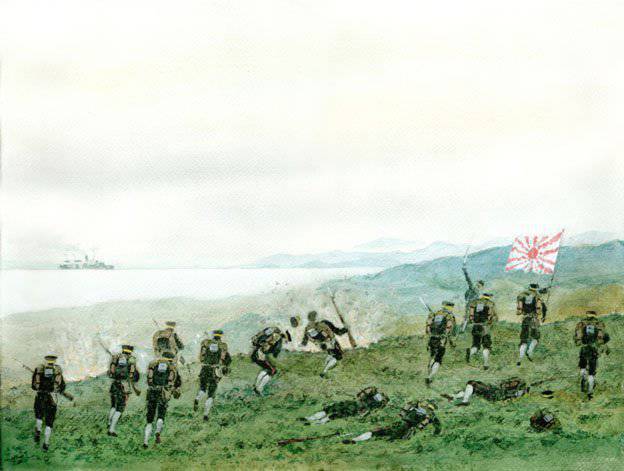
Japanese infantry under the fire of the gunboat "Beaver". Fight under Jinzhou. Artist D. Bazuev
Admiral Togo, who had three battleships, four cruisers and 12 destroyers at the base of the Elliott Islands, did not take part in this battle. After losing two squadron battleships and other ships on mines, he was afraid to take risks. Rear Admiral Vitgeft confined himself to a single sending of three ships, refusing more serious support for the Jinzhou position under various pretexts. Although the successful experience of the "Beaver" showed that the fleet could provide more serious support to the ground forces and slow down the advance of the Japanese troops. True, it was obvious that the fleet itself could not hold positions with Jinzhou, since the command of the land forces did not have the desire to hold them to the last.
Initially, the Japanese went on a frontal assault on the heights of the isthmus. The Japanese command consistently conducted eight massive attacks. However, they were repulsed by artillery and rifle-machine-gun fire. Times Japanese soldiers broke into the distance 25-30 meters from the Russian positions, but they were rejected. A foreign military observer at the headquarters of the 2 Army, British Colonel V. Apsley Smith reported to the authorities: “The battle was very stubborn. The Japanese infantry was relatively easy to reach the ground at 300-600 yards from the target, but further repeated attempts to move forward did not produce results. ” Another foreign observer, English Lieutenant General Ian Hamilton, noted the resilience of Russian soldiers and officers.
All attacks by the Japanese during the first half of the day were repelled with heavy losses for the Japanese. 1-I and 3-I divisions could not achieve at least a small tactical success. But then the situation worsened. The Japanese discovered the positions of all Russian batteries and opened fire on them. As a result, the Russian artillery fell silent - part of the guns was disabled (many guns were in open positions), while others simply ran out of ammunition. It must be said that on this day the battery of captain L. N. Gobyato was particularly distinguished, which was located in a closed position near the village of Liodiatun. Battery Gobyato successfully fired a concentrated fire at the enemy artillery position on Mount Samson. Russian gunners suppressed the Japanese battery, while they themselves did not suffer losses during an artillery duel.
In the first stage of the battle, victory was left to the Russian troops. They repelled all attacks. Enemy infantry in any direction could not approach the Russian trenches closer than a kilometer. Only the 4 Division was a local success. Using the good natural obstacles that existed on the Russian left flank and were supported by ship fire, the Japanese soldiers were able to advance. But at low tide, when the ships sailed into the sea, the 4 Division also stopped.
However, there have been alarming trends. Russian artillery was knocked out or did not have ammunition. On the left flank, Japanese troops had strong support from the sea. General Fok did not lead the battle. In the morning he left the command post and went to the rear to prepare positions in case of the landing of the Japanese landing force. Returning to dinner, Fock sent Colonel Tretyakov, who became a true hero of the defense of Port Arthur, an order not to retreat without his permission. This was the end of the “command” by the divisional commander Fock during the first phase of the battle. Stoessel remained in Port Arthur, and his only leading order was an instruction to use the 6-inch (152-mm) Kane cannon, which was brought several days before the fight. But she did not have time to install.
In 12 hours 35 minutes, General Fock, who studied the consequences of the first stage of the battle, sent Colonel Tretyakov quite a sensible indication - he noted the danger on the left flank. There really was a dangerous situation. The enemy's 4 Division, taking advantage of the terrain features and support of the ships, and not counting the losses, could have broken through the Russian defenses. However, Fok, who was the head of Jinzhou’s defense, had to transfer the reserves and artillery to the threatened area himself, and not give advice to Tretyakov. The Japanese led fierce attacks in all directions and huge forces, Tretyakov did not even have a company to reinforce the left flank. Therefore, he replied to Fok that there are no free soldiers, and that he can only hope for the boldness and courage of the soldiers and officers.
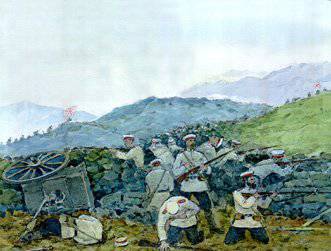 Around 2 hours of the day, the Japanese army, after artillery preparation, went on a new assault on the Russian positions. Again a furious battle began to boil. The Japanese suffered great losses, but stubbornly rushed forward. By 4 hours of the day the Japanese were exhausted. General Fok again visited the position, but did not even meet with Tretyakov, and without giving more than one order, he retired.
Around 2 hours of the day, the Japanese army, after artillery preparation, went on a new assault on the Russian positions. Again a furious battle began to boil. The Japanese suffered great losses, but stubbornly rushed forward. By 4 hours of the day the Japanese were exhausted. General Fok again visited the position, but did not even meet with Tretyakov, and without giving more than one order, he retired. 2-I army suffered significant losses. So, the 1 division had to be reinforced by two battalions from the army reserve. The 3 division, which suffered great losses from the fire of Russian ships and was hit by batteries from Tafashi heights, was also in a difficult situation. It had to be strengthened with the last battalion from the army reserve. The commander of 2 of the Japanese army, Lieutenant-General Baron Oka, in a report to the imperial commander-in-chief, Marshal Iwao Oyame, noted that due to the stubborn resistance of the Russian infantry, the situation did not change until noon 5. Until that time, the Japanese could not find any gaps in the Russian defense. The troops suffered heavy losses, and the further offensive seemed meaningless.
However, General Oka decided on another assault. He decided to make a decisive attack on his right flank, where there was a small success on the site of the 4 division. After a new long-term artillery preparation of the enemy’s position, which was supported by gunboats and destroyers, the 4 Division launched a decisive offensive. Coastal Russian trenches under the powerful fire of Japanese artillery were almost completely destroyed. The heavily thinned ranks of Russian archers, which did not have the support of artillery, could not stop the thick chains of the enemy.
The surviving soldiers of the 5 and 7 mouth of the 5 regiment began to retreat. Japanese troops were able to penetrate into the Russian position. Noticing the retreat on the left flank, and not understanding the situation, the units defending the right flank also withdrew. The Japanese quickly took the left positions. The troops began to retreat to the second, weaker position on the line of the Gulf of Longvantan - the village of Suantsaygou. Only in the center of the company 5 of the East-Siberian rifle regiment continued to hold on to their positions even being surrounded. Siberian riflemen greeted the enemies on all sides and were killed in an unequal struggle. Nobody surrendered to captivity.
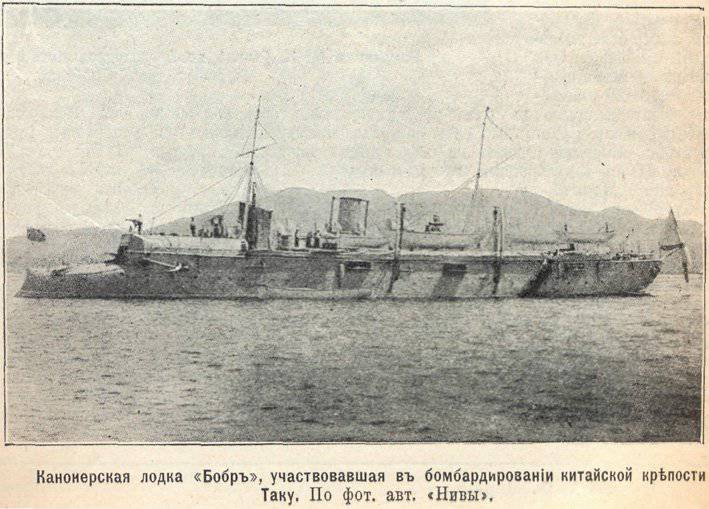
Results
The battle of Jinzhou became one of the bloodiest in this war. The Japanese army lost about 4,5 thousand people killed and wounded (according to other sources, about 5 thousand people), that is, up to 10% of the personnel of the entire army. Russian troops lost about 1,4 thousand people (according to other sources, 1,6 thousand people). The 5 th infantry regiment lost more than a third of its composition and more than half of its officers. The Japanese seized almost all Russian artillery and machine guns, since the command did not take measures to evacuate them.
Militarily, the failure of the defense of the Jinzhou position was determined by several factors. Firstly, long-term fortifications were not built in advance, which could turn the narrow isthmus into a powerful fortress, for which the Japanese army would have to spend a lot of time, resources and forces to take. Actually, the Russian command did not intend to defend the Jinjo position at all for a long time and stubbornly.
Secondly, the artillery position was located in open positions, as in the battle on the Yalu River, and was easily struck by the enemy’s artillery. The fire link between the individual units was poorly organized. Artillery did not have a significant stock of ammunition, and the projectiles were not delivered. As a result, the Japanese in the first half of the day suppressed the Russian artillery, or it did not have ammunition to support the infantry.
Third, the main forces of the 4 of the East-Siberian rifle division, Major General A. V. Fock (14, thousand bayonets) and its artillery did not take part in the battle at all. Although their entry into battle, the Russian counter-attack, especially when the forces of the Japanese 2 Army were drained of blood and the Japanese had already lost hope of taking Russian positions, could generally lead to the victory of the Russian army. The 2 army would have to withdraw and regroup to repeat the attack. Some military researchers generally believe that if the entire body of Stessel had been thrown into the battle, and not just one regiment, the Japanese army would have been defeated, which could lead to the interception of the strategic initiative in the war. However, Fok and Stessel withdrawn from the battle. The high command not only failed to organize a counterstrike, but also did not take measures for an organized retreat. This led to unnecessary losses, loss of artillery, unnecessarily rapid retreat to Port Arthur.
Fourth, all the capabilities of the Port Arthur Squadron were not used. Although a good example of the actions of the cannon "Bobr" proved that the fleet could provide more effective support to ground forces.
The defeat of Jinzhou led to the rapid retreat of the Russian troops. All positions and villages were left, the troops pulled back to Port Arthur. The road to Port Arthur was open. On the night of May 27, Russian troops retreated to Nangalin Station (Nanguanling). At the same time, General Fok ordered to leave the port of Dalny. In fact, the port was just abandoned. The military engineer of the port, Captain Zedgenidze and Lieutenant Sukhomlin, on their own initiative, began to destroy everything that was possible. But due to lack of time and manpower simply did not have time. The Japanese were able to capture most of the port facilities safely and securely, which allowed them to use the Far East as their naval base, transit point and rear base of the 3 Army. For example, the Japanese seized more than 100 warehouses and barracks, railway workshops, a power station, trolleys for the narrow-gauge railway, more 400 cars, 50 various sea cargo ships, a large supply of rails and coal. It is through the Far to Port Arthur that heavy 11-inch howitzers will be transferred. Transporting them through Korea, where there were no good roads, would take many months.
I must say that the Japanese themselves and in no hurry to move to Port Arthur. They occupied the Far only four days later, as the Russians left it. 2-I army did not pursue the division Fock. Oka left a barrier at Jinzhou and with the main forces moved on the Liaoyan direction to block the road of the Russian Manchurian army. Against Port Arthur, the 3 Army, under the command of the Foot, was to operate. Its basis was the 1-division, which Oka left on the port-arthur direction. Soon Legs arrived, his headquarters and the first connections of the 11 division. It was Marasuke Feet during the Sino-Japanese War that commanded the first infantry brigade, which captured Port Arthur in one day. In early June, Feet had only 30 thousand soldiers and reserves he did not have. The Japanese general did not lead an offensive action and was actively preparing for defense, fearing the active offensive actions of the Port Arthur garrison.
The battle at Jinzhou radically changed the situation for the Russian fleet. On May 27, Rear Admiral Witgeft convened a military council and raised the question of what to do: 1) break into Vladivostok; 2) seek decisive battle with the enemy fleet; 3) to stay in Port Arthur and defend the fortress until the last opportunity and only after the destruction of the defense give the last battle to the enemy fleet. The Council decided by a majority of votes to remain in Port Arthur and to defend the fortress with all its might. The council adopted a second important decision. It was assumed that at a critical moment in the situation of the Port Arthur Fortress, when all the possibilities for defense were exhausted, the fleet would go to sea to break into Vladivostok or engage in battle with the enemy fleet, with any balance of forces. True, it was obvious that this decision was impossible. With the full surrender of forces and means in the defense of Port Arthur, the fleet simply can not go to sea and, moreover, give battle to the enemy.
It is believed that this was a mistake that led the Port Arthur squadron to death. A breakthrough of the fleet in Vladivostok, its preservation and actions on enemy communications could bring more benefits to the armed forces of the Russian Empire. Thus, the captain of 2 rank Essen, a follower of Makarov, believed that the fleet should go to the sea, where it would bring more benefits. The fleet did everything possible for the defense of the fortress, putting minefields, bringing guns and machine guns to the coastal fortifications and sending part of the crews to the forts. The fleet had to leave the guns and break through to Vladivostok. There it was possible to repair ships, replenish the missing armaments and, together with the Vladivostok cruiser detachment, strike the enemy and take possession of the sea. This would save Port Arthur. The commander of the battleship Retvizan, captain of the 1 rank Shchennovich, also spoke in favor of going to sea. Their views were shared by many officers on ships.
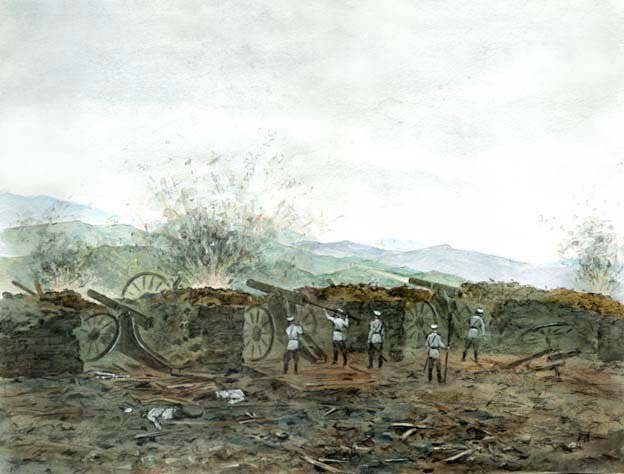
Battery # XXUMX firing at Japanese artillery. Fight under Jinzhou. Artist D. Bazuev
- Alexander Samsonov
- Battle for the "Port Arthur Gate". Fight jinzhou
Battle for the "Port Arthur Gate". 2 part
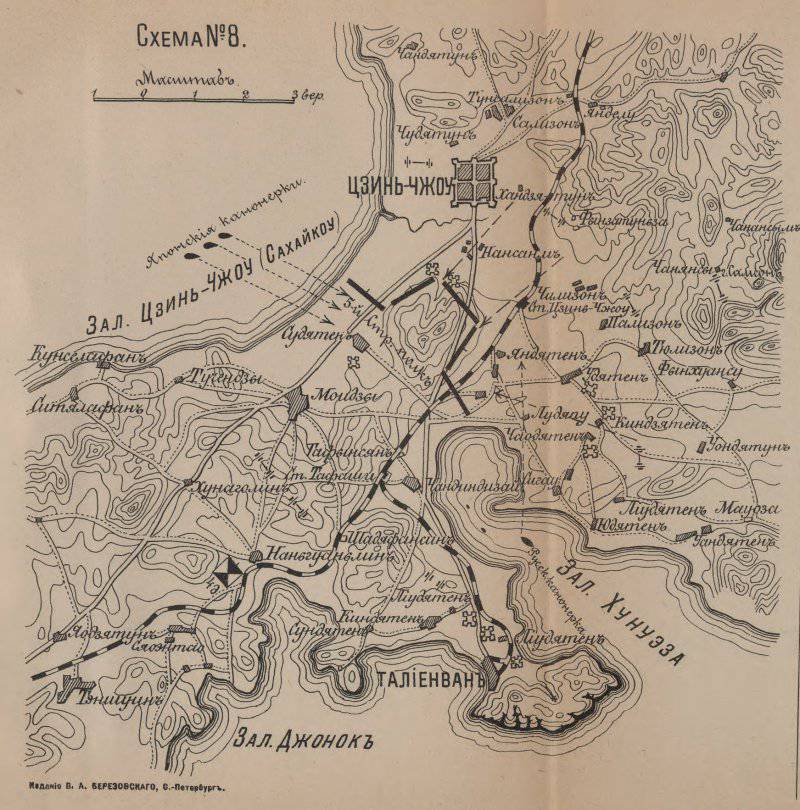
Information